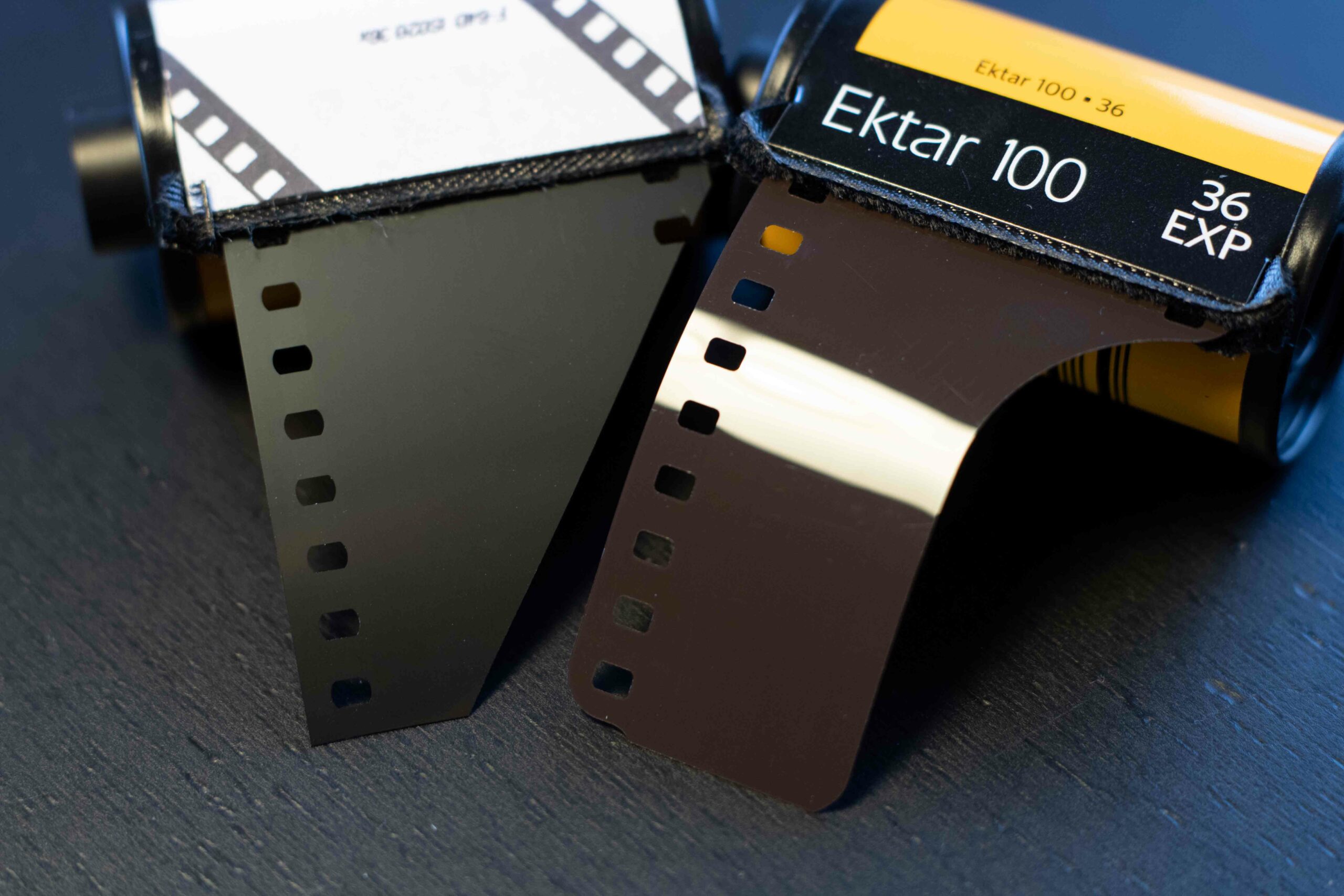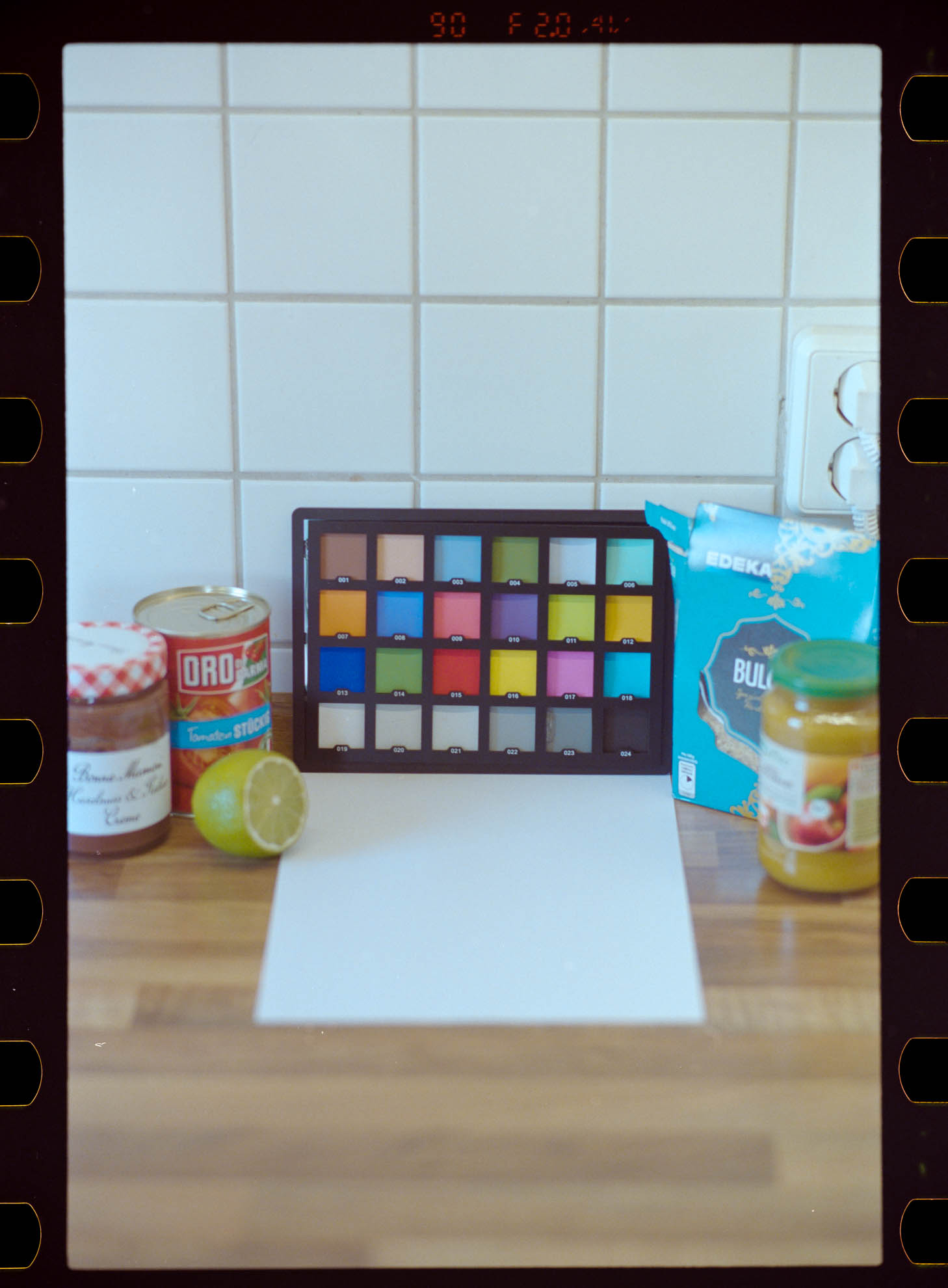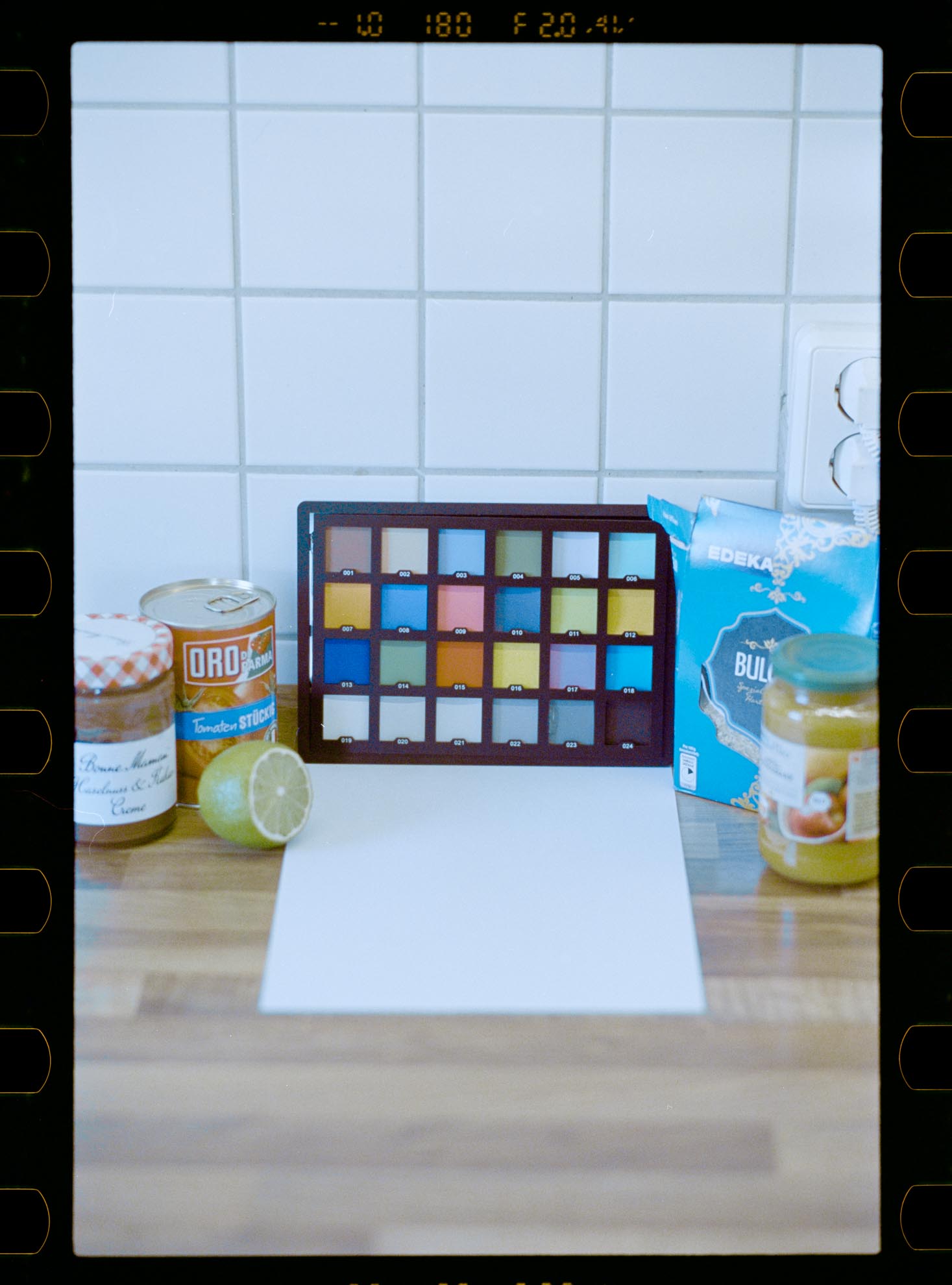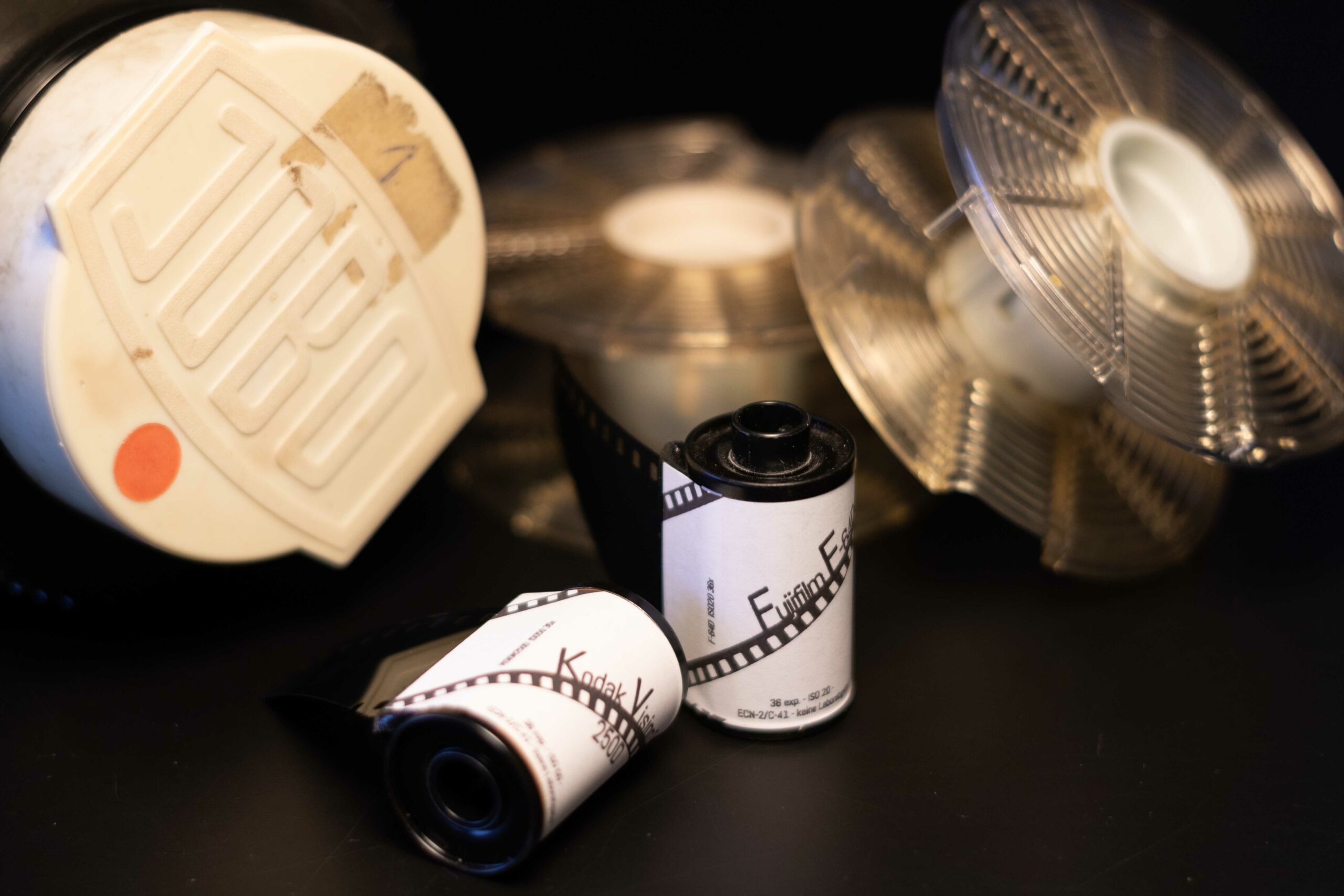Your cart is empty.
Development
This is probably the most important topic when it comes to 35mm cinema film. Therefore, the following is a guide to using films such as Kodak Vision or Fuji Eterna in ECN-2 or C-41 to develop. You will also find a List of labs, who develop the films for you.
1. Motion picture film vs. normal film
1.1 Remjet
1.2 ECN-2
1.3 C-41
2. Home development
2.1 ECN-2
2.2 C-41
1. Motion picture film vs. normal film
1.1 Remjet
The remjet is a protective layer that is applied to the back of the film, with the emulsion on the front. The remjet protects the film from scratches, static discharge and reflections around highlights.
This black layer must be removed before the film is developed, which is why the ECN-2 process exists. In addition, it is therefore not possible to dispense the film at a normal laboratory, as the remjet would run their chemistry and contaminate the machine

Left motion picture film with Remjet
1.2 ECN-2
The ECN-2 development process was created by Kodak especially for motion picture film and is characterized by the following properties in addition to the removal of the remjet:
- Natural colors
- Moderate contrast
- All Fuji films, as well as expired material from Kodak, deliver significantly better colors and dynamic range in ECN-2
There are currently three development kits available on the market. The kits from Bellini and Jobo, who have implemented the entire process for home users in 6 steps. As well as Cinestill, who offer a simplified kit with 3 steps.

A neutral overall impression / Kodak Vision3 500T in ECN-2
1.3 C-41
As motion picture film is intended for ECN-2, developing with the C-41 process is so-called “cross processing”. This has the following effect on the negatives:
- Clearly richer, partly reddish shifted colors
- Higher contrast
- Pushes the film +1 Stop
- All Fuji films, as well as expired material from Kodak, usually produce distorted and dull colors in C-41
One advantage is that C-41 developing kits are available everywhere and are relatively inexpensive. After all, you can also develop your normal color films with a C-41 kit.
Basically, all available C-41 kits are suitable. If you want to save some time, buy a kit in which the two steps Bleach and Fix are combined as Blix.

Slight color shifts / Kodak Vision3 500T in C-41
2. Home development
2.1 ECN-2
I use the Bellini ECN-2 kit in the 3L version, as it is the cheapest per roll of film.
Procedure
1. Prebath (~38 °C)
– 1 min rotation or 2 min standing (tilt slightly every 30s)
2. water (~38 °C)
– Pour in, shake vigorously and tip out until no more Remjet comes out
3. ECN-2 process
– Developer, stop, bleaching and fixing bath according to manufacturer’s instructions
– Rinse with water after fixing bath
4. clean
– Remove the film from the reel
– Pour water into the sink/bucket/pot
– Carefully remove Remjet residues from the film in a water bath using fingers/sponge
– (For hard water): Stabilizing bath or Photo Flo according to manufacturer’s instructions
5. drying
2.2 C-41
If you have opted for the C-41 process, the remjet remover is mixed first and then the normal C-41 process is run through with two additional steps.
Remjet remover recipe: 2.5 tablespoons of baking soda per 1 liter of water (~38°C), stir well.
Procedure
1. remjet remover (~38 °C)
– Pour in
– shake vigorously for 30s, wait 30s, shake vigorously for 30s
– Pour out
2. water (~38 °C)
– Pour in, shake vigorously and tip out until no more Remjet comes out
3. c-41 process
– Developer, bleaching and fixing bath according to manufacturer’s instructions
– Rinse with water after fixing bath
4. clean
– Remove the film from the reel
– Pour water into the sink/bucket/pot
– Carefully remove Remjet residues from the film in a water bath using fingers/sponge
– (For hard water): Stabilizing bath or Photo Flo according to manufacturer’s instructions
5. drying
3. Labs
Here is a list of laboratories that develop 35mm motion picture film in Europe, North and South America;
There will be only labs listed that develop motion picture film in film cartridges for 35mm cameras. There are many laboratories that develop motion picture film, but mostly for film productions where the film strips are longer (+50m) and easier to handle. A film for 36 pictures is only 1.7 meters long and is simply too short for some developing machines.
Some labs develop with the ECN-2 process, others with C-41. The difference is explained in 1. motion picture film vs. normal film
Europe
Germany
Berlin, Film Speed Lab
Berlin, Safelight
Berlin, Aperture Film Lab
Dresden, Foto Görner
Frankfurt, On Film Lab (Only V3)
Belgium
A Film Lab
Laboriver
Czech Republic
Filmstore
Finland
Kamerastore
Martax Film Lab
France
L’atelier Argentique
Nation Photo
Sunbath Film-Lab
Italy
DP66
Ghisa Film Lab
Lithuania
Baltijas Foto Serviss
Netherlands
Analog Space
Cameralisatie
Austria
Fotolabor Krzysztov Wolczak
Fotospeed
Garage Film Lab
Unwind Film Lab
Poland
Czarno-Białe
Jasna Ciemnia
Portugal
Carmencita Film Lab
Sagrada Película Film Lab
Slovakia
Film labák
Spain
1826 Film Lab
Amigou Lab
Artística Marciana Lab
Carmencita Film Lab
Contado Pierde
Fotocarrete
Interphoto
Revelab
Ukraine
Fotovramke
Photokava Film Lab
Photovision
Hungary
Cafe Analog
Worldwide
Great Britain
Analogue Wonderland
Filmprocessing.co.uk
Gulabi Photo
J&A Photography Studio
Jack’s Lab
Nik & Trick Photo Services
Take It Easy Lab
The Film Safe
USA
Bellows Film Lab, Florida
Palm Film Lab, Florida
Dunwoody Photo, Georgia
Midwest Film Company, Kansas
Old School Photo Lab, New Hampshire
Blue Moon Camera & Machine, Oregon
Andrew’s Analog Service Center, Pennsylvania
Boutique Photo Lab, Tennessee
Shot On Film Store, Washington

